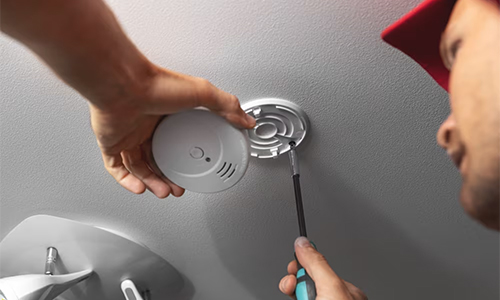Carbon Monoxide Safety Kitchener – Waterloo – Cambridge
Carbon Monoxide Safety: Protecting Your Home and Family
Carbon monoxide (CO) is a colorless, odorless, and tasteless gas that can be deadly if inhaled in high concentrations. It is often referred to as the “silent killer” because it is difficult to detect without specialized equipment, and many people may not realize they are being exposed to it until it’s too late. The source of carbon monoxide is often the incomplete combustion of fuels such as gas, wood, propane, or coal. Understanding carbon monoxide safety is essential for protecting your home and family from this invisible threat.
At Infiniti HVAC, we are committed to ensuring your home is safe and comfortable. We offer solutions and guidance to help you mitigate the risk of carbon monoxide poisoning and maintain a healthy indoor environment.
What is Carbon Monoxide?
Carbon monoxide is a by-product of burning fuels like natural gas, propane, oil, wood, and charcoal. It can be produced by appliances such as furnaces, stoves, fireplaces, water heaters, and generators, especially when these devices are poorly ventilated or not functioning correctly. When inhaled, CO prevents oxygen from reaching the brain and other vital organs, which can lead to serious health complications or even death.
Common sources of carbon monoxide in homes include:
- Gas appliances (stoves, ovens, water heaters)
- Furnaces, boilers, and other heating systems
- Fireplaces and wood-burning stoves
- Car exhaust in an attached garage
- Gas-powered generators
- Grills and camp stoves used indoors

Symptoms of Carbon Monoxide Poisoning
Carbon monoxide poisoning can present itself in a variety of symptoms, many of which resemble those of the flu or other common illnesses. It’s important to recognize these signs early to prevent further exposure. Symptoms of CO poisoning may include:
- Headache
- Dizziness or lightheadedness
- Nausea or vomiting
- Shortness of breath
- Confusion or disorientation
- Fatigue or weakness
If you or someone in your household exhibits these symptoms, it’s crucial to leave the premises immediately and seek medical attention. Prolonged exposure to carbon monoxide can lead to permanent damage to the brain and other organs, and in some cases, it can be fatal.
Contact Us to Schedule a Consultation
How to Prevent Carbon Monoxide Poisoning
- Install Carbon Monoxide Detectors: The most effective way to detect carbon monoxide is by installing a CO detector in your home. These detectors are similar to smoke alarms but are specifically designed to detect the presence of carbon monoxide in the air. They should be installed near sleeping areas and on each floor of your home. It’s important to regularly test the detectors and change the batteries at least once a year. Consider upgrading to smart CO detectors that can send alerts to your phone or notify you when the air quality is unsafe.
- Have Appliances and Heating Systems Inspected: Regular maintenance and inspection of heating systems, gas appliances, and other combustion-powered devices can help ensure they are operating safely and efficiently. HVAC professionals should inspect your furnace, stove, fireplace, and water heater annually to check for leaks or malfunctions that could lead to carbon monoxide production. If you have an older appliance, you may need to consider upgrading to a safer, more efficient model.
- Ensure Proper Ventilation: Proper ventilation is essential for preventing the buildup of carbon monoxide in your home. Ensure that vents and chimneys are clear of debris and blockages to allow gases to safely escape. If you have a fireplace, always make sure the chimney is unobstructed. Similarly, ensure that your dryer vents and exhaust fans are functioning properly to help reduce the accumulation of indoor pollutants.
- Never Use Appliances in Enclosed Spaces: Never use gas-powered appliances such as grills, generators, or camp stoves indoors or in an attached garage, even with the door open. These appliances can produce high levels of carbon monoxide that can quickly build up in enclosed spaces. Always use these items outside, far from any open windows, vents, or air intakes.
- Use Your Car Safely: Never leave your car running in an attached garage, even if the garage door is open. Carbon monoxide can quickly seep into your home through gaps around the garage door and into the living areas. Always start your car outside the garage, and if you must run it for any reason, do so in a well-ventilated area.
- Educate Your Family: Make sure everyone in your household understands the dangers of carbon monoxide and knows the symptoms of poisoning. In case of exposure, everyone should know the emergency procedures: evacuating the home immediately and seeking fresh air.
What to Do in Case of Carbon Monoxide Poisoning
If you suspect carbon monoxide poisoning, it’s critical to act quickly. Here’s what you should do:

Evacuate the Area
Immediately leave the home or building where you suspect carbon monoxide exposure. Take everyone with you, including pets.

Call Emergency Services
Once outside, call emergency services and inform them of the suspected carbon monoxide poisoning. Seek medical attention for anyone who has symptoms.

Ventilate the Area:
If it’s safe to do so, open windows and doors to help ventilate the building and expel the gas. However, do not re-enter the building until professionals confirm it is safe.
Why Carbon Monoxide Safety is Critical
Carbon monoxide is especially dangerous because it is undetectable by the human senses. You cannot see, taste, or smell it, making it difficult to recognize without a CO detector. Even low levels of exposure over time can have long-lasting effects, particularly on vulnerable groups such as children, the elderly, and those with pre-existing health conditions. By following carbon monoxide safety guidelines and installing CO detectors, you can reduce the risk of poisoning and protect your loved ones from harm.
Frequently Asked Questions (FAQ)
CO detectors should be installed outside of each sleeping area and on every level of your home. Place them at least 15 feet away from any fuel-burning appliances to avoid false alarms. Avoid placing detectors near windows, doors, or vents where outdoor air could interfere with their operation.
Test your CO detectors at least once a month to ensure they are functioning properly. Replace the batteries at least once a year and replace the entire detector every 5-7 years, as recommended by the manufacturer.
Yes, CO detectors can sound an alarm due to malfunctioning appliances, clogged vents, or other issues. If the alarm goes off, immediately evacuate the building and call emergency services to investigate. Do not ignore the alarm.
Regular inspections by a licensed HVAC professional can help detect leaks in your furnace or other heating appliances. If you suspect that your furnace or another appliance is producing carbon monoxide, get it inspected immediately. Never attempt to fix the problem yourself.
No. Never use a portable generator indoors or in an enclosed space such as a garage, even if the door is open. Generators should only be used outdoors, away from windows and doors, to avoid carbon monoxide buildup in your home.
Ensure that your chimney is clear of debris and regularly maintained. Always keep the damper open when the fireplace is in use to allow the gases to escape. Never leave a fire unattended, and ensure that the fireplace is properly ventilated.
If you suspect a carbon monoxide leak, evacuate the building immediately and call emergency services. Do not re-enter the home until a professional has confirmed it is safe.

